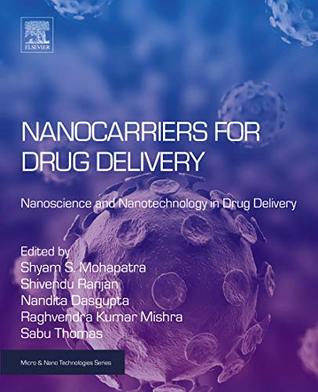Download Nanocarriers for Drug Delivery: Nanoscience and Nanotechnology in Drug Delivery (Micro and Nano Technologies) - Shyam Mohapatra | ePub
Related searches:
Nanocarriers for ocular drug delivery: current status and
Nanocarriers for Drug Delivery: Nanoscience and Nanotechnology in Drug Delivery (Micro and Nano Technologies)
Nanocarriers for Drug Delivery - Concepts and Applications
Nanoconjugate Nanocarriers for Drug Delivery - 1st Edition - Raj K. Ke
Nanocarrier Systems for Transdermal Drug Delivery IntechOpen
Solid lipid nanocarriers in drug delivery: characterization and design
Stimuli-responsive nanocarriers for drug delivery, tumor imaging
Carbon nano-onions as potential nanocarriers for drug delivery
Nanocarriers for Drug Delivery ScienceDirect
Nanocarriers for Drug Delivery - Medical News
Nanocarriers for drug delivery applications SpringerLink
Rx Drug and Medicine Forums - MedsChat.com Prescription Info
Nanoparticles as carriers for drug delivery in cancer
Nanocarriers Used Most in Drug Delivery and Drug Release
Nanocarriers for Drug Delivery Max Planck Institute for Polymer
Medical nanoparticles for next generation drug delivery to the lungs
Development of Nanocarriers for Cancer-Targeted Drug Delivery
nanocarrier drug delivery Systems for Colorectal - LWW Journals
Nanocarriers for Drug Delivery • Haag Group • Department of
Extracellularly activatable nanocarriers for drug delivery to
Multifunctional Nanocarriers for Lung Drug Delivery
Intrinsic stimuli‐responsive nanocarriers for smart drug
Nanocarriers for Nitric Oxide Delivery
2385 1096 276 4829 3590 3315 3757 2295 2969 1132 3514 1109 4998 3297 4070 3509 921 1022 36 2771 657 67 927 3170 7 2071 4182 234 58 1387 1382 3356 257 827
Nanoparticulate drug carriers can offer several features useful for the delivery of chemotherapeutic drugs. For example, nanoparticles (nps) made of amphiphilic polymers can be used to solubilize hydrophobic drugs in aqueous media.
Many synthetic polymers have found application as nanocarriers of intelligent drug delivery systems (ddss).
Effective use of nanocarriers as drug delivery systems for the treatment of selected tumors.
Dec 4, 2020 drug delivery systems, resistance, nanomedicine, cancer treatment polymer based nanocarriers, polymeric micelles, high drug entrapment.
Commonly used nanocarriers include micelles, polymers, carbon-based materials, liposomes and other substances. Nanocarriers are currently being studied for their use in drug delivery and their unique characteristics demonstrate potential use in chemotherapy.
The max-planck-institute for polymer research ( mpi-p) and the university medicine of the johannes gutenberg-university.
Spurred by recent progress in materials chemistry and drug delivery, stimuli-responsive devices that deliver a drug in spatial-, temporal- and dosage-controlled fashions have become possible. Implementation of such devices requires the use of biocompatible materials that are susceptible to a specifi.
Stimuli responsive nanocarriers for the controlled transport of active compounds supramolecular drug-delivery systems based on polymeric core-shell.
Aug 9, 2019 novel systems for drug and vaccine administration based on nanocarriers represent a promising avenue for chagas disease treatment.
Nanostructures have always been a fascinating drug delivery vehicle for addressing bioavailability, targeted delivery and enhancement of therapeutic potential of drugs. Recent developments have provided a strong scientific rationale for considering mesoporous silica nanoparticles as highly efficient drug delivery carriers.
The use of polymeric nanoparticles and micelles as nanocarriers for drug delivery has been extensively investigated. These systems can be used to increase the aqueous solubility of drugs and to modulate drug activity by passive or active targeting to different tissues.
Nanocarriers have been developed for efficient drug delivery and diagnostic tools. Nanocarrier enables an effective, targeted biomolecular interaction in order to lower side effects caused during the treatment. Here, we review the problems associated with the conventional drug development and its delivery system.
This article gives a brief overview on the emerging field of nanocarriers as drug delivery vehicles for the treatment of lung diseases.
Some of these applications include dna/rna nanotechnology, diagnosis by molecular imaging, biosensing, nanomedicine, and nanocarriers for drug delivery.
Various nanocarriers, including nanodispersion systems, nanomicelles, lipidic nanocarriers, polymeric nanoparticles, liposomes, niosomes, and dendrimers, have been investigated for improved permeation and effective targeted drug delivery to various ophthalmic sites.
The concept of engineered nano-carriers may be a promising route to address.
Nanocarriers are nano-sized delivery vesicles that can transport desired molecules to a specific location.
Mar 3, 2020 scientists have developed an innovative nanocarrier that can selectively target and deliver a chemotherapy payload to cancer cells.
Organic nanocarriers reported for osteosarcoma drug delivery mainly include liposomes, polymers, micelles, and dendrimers. And inorganic nanocarriers mainly include metallic nanoparticles, mesoporous silica nanomaterials, carbon-based nanomaterials, and calcium phosphates carriers.
Description nano-carriers for drug delivery: nanoscience and nanotechnology in drug delivery presents recent discoveries in research on the pharmaceutical applications of the various types of nanosystem-based drug delivery systems. As many nanosystems have reached the market over the past decade, this book proves their benefits to patients.
Introduction: solid lipid nanoparticles are promising drug carriers for systemic circulations as well as local applications.
Nanoparticle drug delivery systems are engineered technologies that use nanoparticles for the targeted delivery and controlled release of therapeutic agents. The modern form of a drug delivery system should minimize side-effects and reduce both dosage and dosage frequency.
Nanocarriers have been increasingly proposed for lung drug delivery applications. The strategy of combining the intrinsic and more general advantages of the nanostructures with specificities that improve the therapeutic outcomes of particular clinical situations is frequent.
Mar 15, 2020 nanocarriers could respond to stimuli in tumor microenvironments or inside cancer cells for on-demanded drug delivery and accumulation,.
Intrinsic stimuli‐responsive nanocarriers have gained significant interest in the antibacterial research field. In this review, we discuss the potential of these nanocarriers for improved antibacterial drug delivery and highlight further research required to optimize their potential.
Nanocarriers for drug delivery the max-planck-institute for polymer research (mpi-p) and the university medicine of the johannes gutenberg-university mainz work together to bring drug delivery systems to the clinic. This bridges the gap between medical need and excellent basic science.
Mar 5, 2021 effective colon targeted drug delivery systems (ddss) thus, a great number of novel nanocarriers—such as liposomes, micelles, carbon.

Post Your Comments: